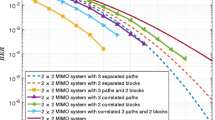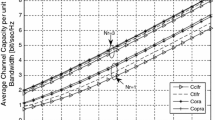Abstract
Wireless Mobile Communications rely on a host of techniques, all related to one goal, sending the most possible information accross a link or a network. In recent years, both spatial and multiuser diversity have proven to be key techniques to achieve this goal. These two diversity dimensions can be exploited by the use of multiple antennas and/or the use of multiple terminals sending at the same time/frequency/code, these terminals can be seen as a multiple antenna emitter. This transmission diversity can be achieved with cooperative space-time encoded transmissions. One of the practical problems with this sort of array of transmitters is that the emitters will be asynchronous to some extent, hence the need for systems that can deal with asynchronicity, both from a signal design point of view and from a signal processing point of view. Having tackled the signal design previously, we take a look at the signal processing aspect and present a channel and delay estimation algorithm for asynchronous cooperative diversity in Block-Flat-Fading channel. The signal design is based on a precoding frame-based scheme with packet-wise encoding. This precoding is based on the addition of a cyclic prefix, implemented as a training sequence. The signal processing takes advantage of the known symbols offered by this cyclic prefix/training sequence and we show that it enables best synchronization and channel estimation which reaches the Cramer-Rao Bound. The BER performances are the same as synchronous MRC case, with full diversity order.
Similar content being viewed by others
References
M. Dohler, Virtual Antenna Arrays, Ph.D. thesis, University of London, United Kingdom, 2004.
E. Erkip, A. Sendonaris, and B. Aazhang, “User Cooperation Diversity,” Part I, II,” IEEE Trans. Comm., Vol. 51, No. 11, pp. 1927–1948, Nov. 2003.
X. Li and N. E. Wu, “Power Efficient Wireless Sensor Networks with Distributed Transmission-induced Space Spreading”, in Proc. 37th Asil. Conf. Signals, Syst., Comput., Pacific Grove, CA, Nov. 2003.
J.N. Laneman and G.W. Wornell, “Distributed Space-time-coded Protocols for Exploiting Cooperative Diversity in Wireless Networks,” IEEE Trans. Inform. Theory, Vol. 49, No. 10, pp. 2415–2425, Oct. 2003.
X. Li, “Space-time Coded Muli-transmission Among Distributed Transmitters without Perfect Synchronization,” IEEE Signal Processing Letters, Vol. 11, No. 12, pp. 948–951, Dec. 2004.
K. Tourki and L. Deneire, “Precoding and Distributed STBC for Asynchronous Cooperative Diversity.”, in International Wireless Summit: Wireless Personal Multimedia Communications, Aalborg. Denmark, Sep. 2005.
C. Budianu and L. Tong, “Packet Design for Communication Under Asynchronous Interference”, in Proc. of MILCOM, Boston, MA, Oct. 2003.
M.K. Simon and M.S. Alouini (Eds.), Digital Communication over Fading Channels, A Unified Approach to Performance Analysis, Wiley Series in Telecommunications and Signal Processing, 2000.
Author information
Authors and Affiliations
Corresponding author
Rights and permissions
About this article
Cite this article
Tourki, K., Deneire, L. Channel and Delay Estimation Algorithm for Asynchronous Cooperative Diversity. Wireless Pers Commun 37, 361–369 (2006). https://doi.org/10.1007/s11277-006-9033-x
Received:
Accepted:
Published:
Issue Date:
DOI: https://doi.org/10.1007/s11277-006-9033-x




